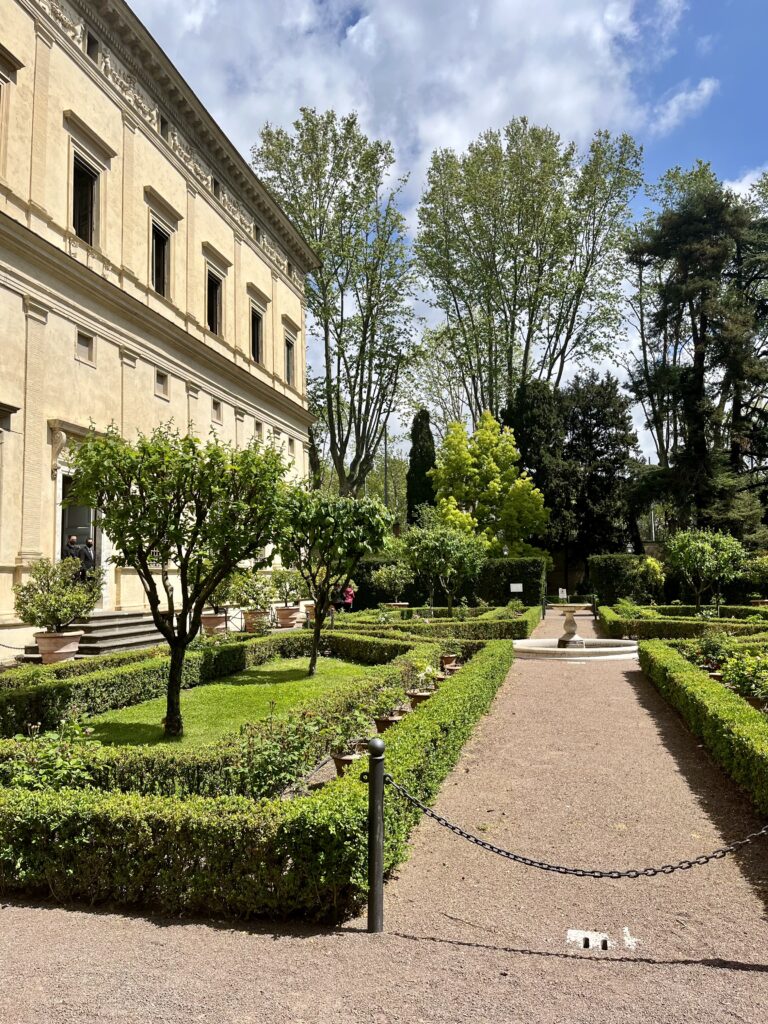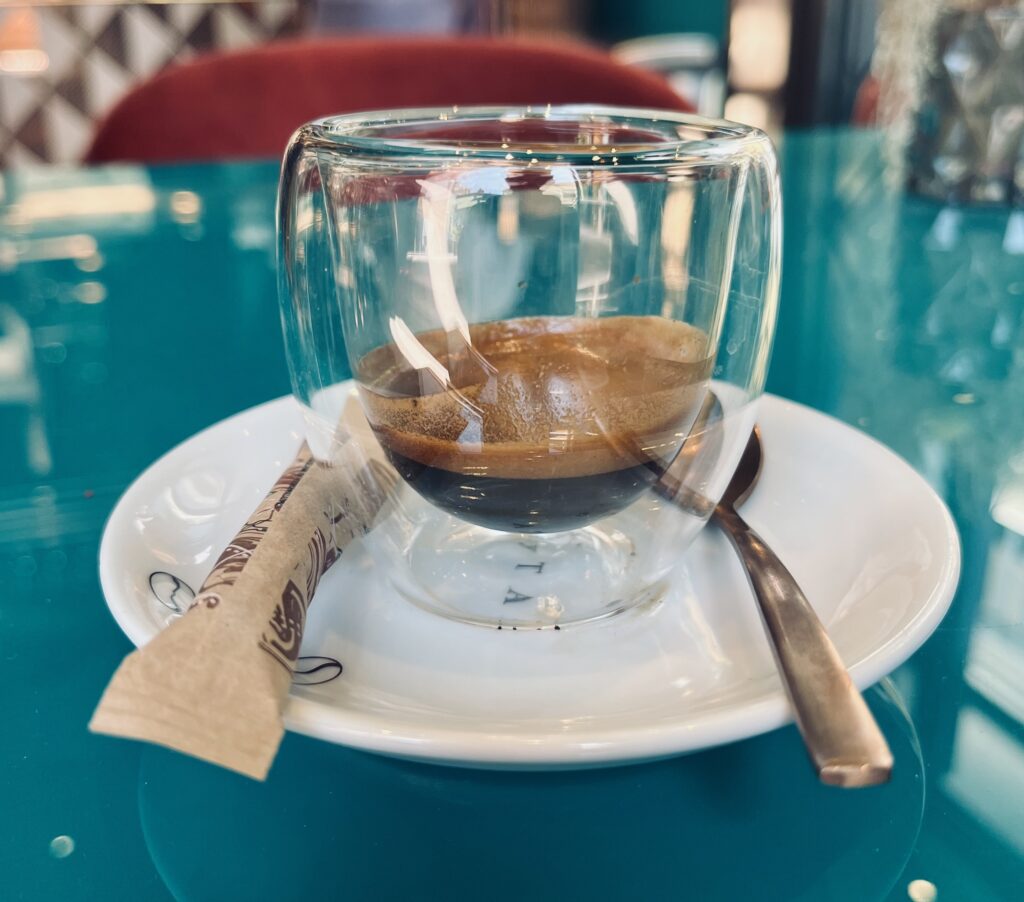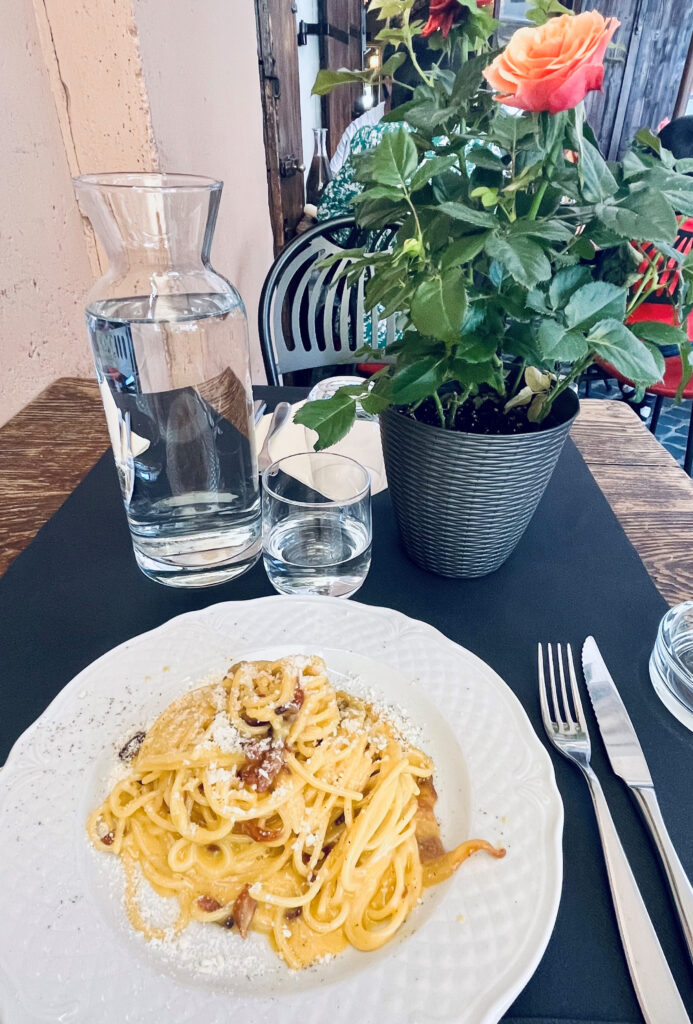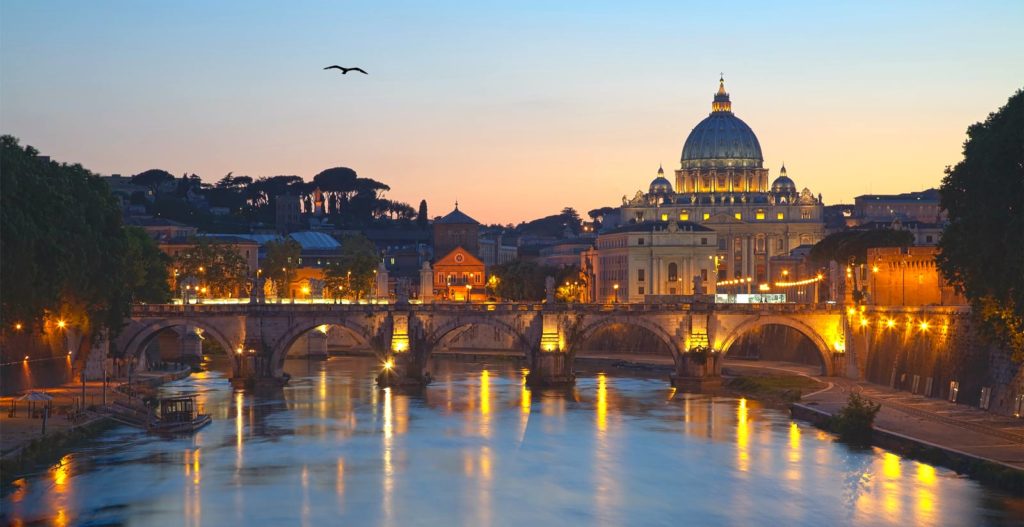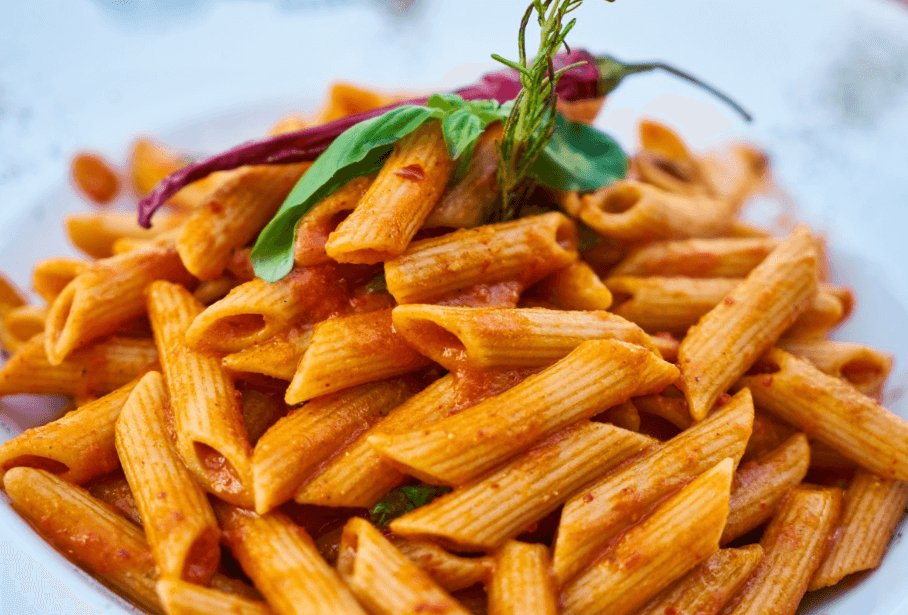Rome Highlights >
Rome food: 5 Must-Eats
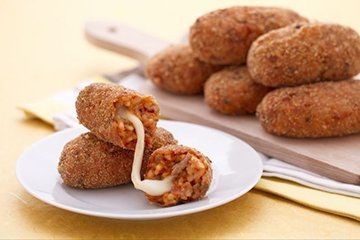
When in Rome food is of the essence. Never stop eating. This really should be your motto. Monuments are nice to look at, yes, but let’s face it, good food is nice to look at, it smells heavenly and is wonderful on the taste buds. Three happy senses in a single action: Eating. Pizza 1, Colosseum 0. The Eternal City is truly a playground for food lovers who will be overwhelmed by the options. Below is our fantastic five of our Rome food list.
1. The supplì
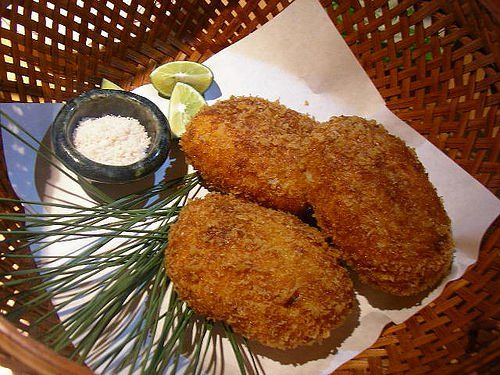 The name kind of sounds like it’s short for “supplication”… rightfully so. You will indeed beg to have more after you eat your first supplì. This snack is an important element of “street” Rome food. Unlike its Sicilian cousin, the arancino (fatter and rounder), the supplì is a “lighter” version, one that can easily be eaten in 5 bites. You’ll quickly develop an addiction to this fried ball of tomato flavored rice which harbours a perfect little piece of melted mozzarella at its center. When you first thought reasonable to have an apple or a pear for a late afternoon snack, after you discover the joys of the supplì, the apple/pear idea will no longer make sense to you and all you’ll want is a supplì. You’ll develop different strategies to savour it without finishing it too quickly. You may break it in half to see the strings of mozzarella stretch before your eyes… Even adults remain fascinated by this phenomenon. You’ll develop preservation mechanisms to make sure that your fried ball of rice stays by your side for as long as possible. And then, when all fails, and the inevitable happens, and all you’re left with is a greasy napkin in your hand, you will get another one without a second thought. There are plenty of places in Rome which offer delicious supplìs, as well as different variations of it (cacio e pepe, eggplant, etc). Here are a few that serve this typical Rome food: La Gatta Mangiona, Sisini La Casa del Suppli and Supplizio.
The name kind of sounds like it’s short for “supplication”… rightfully so. You will indeed beg to have more after you eat your first supplì. This snack is an important element of “street” Rome food. Unlike its Sicilian cousin, the arancino (fatter and rounder), the supplì is a “lighter” version, one that can easily be eaten in 5 bites. You’ll quickly develop an addiction to this fried ball of tomato flavored rice which harbours a perfect little piece of melted mozzarella at its center. When you first thought reasonable to have an apple or a pear for a late afternoon snack, after you discover the joys of the supplì, the apple/pear idea will no longer make sense to you and all you’ll want is a supplì. You’ll develop different strategies to savour it without finishing it too quickly. You may break it in half to see the strings of mozzarella stretch before your eyes… Even adults remain fascinated by this phenomenon. You’ll develop preservation mechanisms to make sure that your fried ball of rice stays by your side for as long as possible. And then, when all fails, and the inevitable happens, and all you’re left with is a greasy napkin in your hand, you will get another one without a second thought. There are plenty of places in Rome which offer delicious supplìs, as well as different variations of it (cacio e pepe, eggplant, etc). Here are a few that serve this typical Rome food: La Gatta Mangiona, Sisini La Casa del Suppli and Supplizio.
2. Spaghetti cacio e pepe
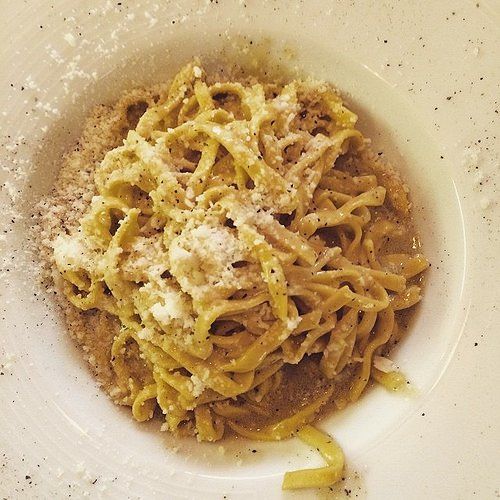 Three measly ingredients can potentially lead to the best plate of pasta you’ll ever have… it’s all in the proportions and in the quality of those three ingredients. But it’s usually the most simple recipes with the least number of ingredients that are the most difficult to get right (ever got a meringue right the first time?)! The traditional Roman pasta dish of “cacio e pepe” which translates to “cheese and pepper” combines thin spaghetti, black pepper and Pecorino Romano cheese. The secret in making this dish a success lies in your ability at leaving just enough hot water in the pot after draining the spaghetti. The heat of the water will melt the Pecorino which will beautifully envelop the pepper. Too dry? Add more water to the mix! Too watery? Add more cheese! Keep up the negotiation between water and cheese until you are fully satisfied with the sauce’s consistency. A perfect cacio e pepe dish will present itself as a healthy marriage between a creamy sauce and “al dente” (firm to the bite) spaghetti. A not-so-yummy cacio e pepe results in the unhappy union of the cheese, the pepper and the pasta. If you don’t feel like going down the road of frustrating trial and error of this tricky Rome food, you may just want to head to the best cacio e pepe near you: Roscioli, Da Checco er Carettiere and Osteria Cacio e Pepe.
Three measly ingredients can potentially lead to the best plate of pasta you’ll ever have… it’s all in the proportions and in the quality of those three ingredients. But it’s usually the most simple recipes with the least number of ingredients that are the most difficult to get right (ever got a meringue right the first time?)! The traditional Roman pasta dish of “cacio e pepe” which translates to “cheese and pepper” combines thin spaghetti, black pepper and Pecorino Romano cheese. The secret in making this dish a success lies in your ability at leaving just enough hot water in the pot after draining the spaghetti. The heat of the water will melt the Pecorino which will beautifully envelop the pepper. Too dry? Add more water to the mix! Too watery? Add more cheese! Keep up the negotiation between water and cheese until you are fully satisfied with the sauce’s consistency. A perfect cacio e pepe dish will present itself as a healthy marriage between a creamy sauce and “al dente” (firm to the bite) spaghetti. A not-so-yummy cacio e pepe results in the unhappy union of the cheese, the pepper and the pasta. If you don’t feel like going down the road of frustrating trial and error of this tricky Rome food, you may just want to head to the best cacio e pepe near you: Roscioli, Da Checco er Carettiere and Osteria Cacio e Pepe.
3. Carciofi alla giudìa
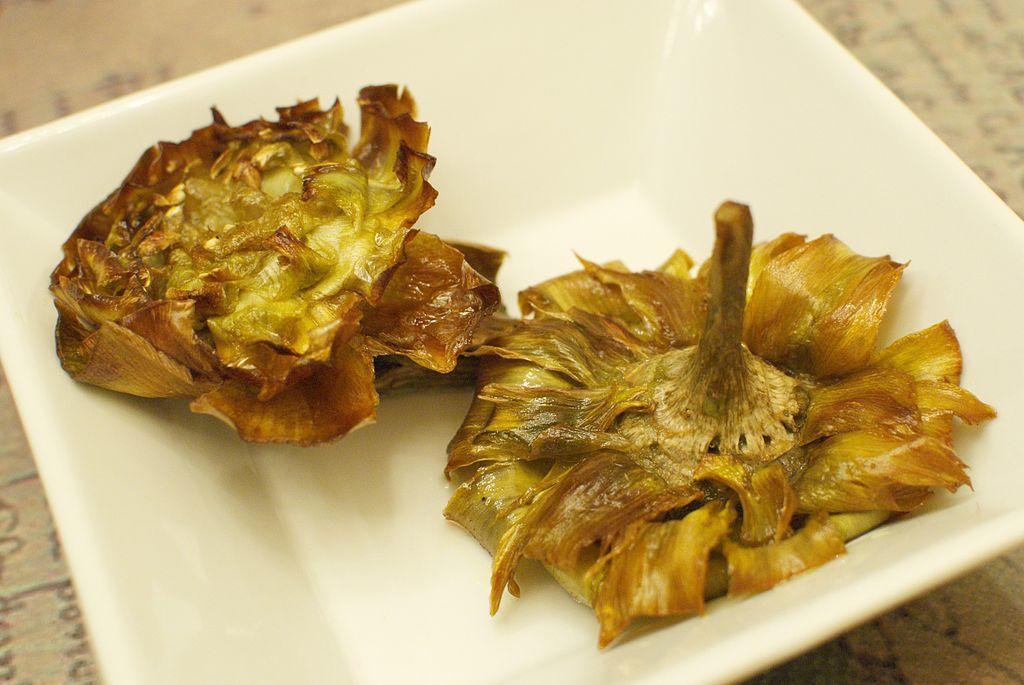 Among the best known dishes of Jewish Roman cuisine, “Jewish-style artichokes” rank very high. They are a delicious appetizer to sample during the spring time when artichokes are at their prime, having been harvested between the months of February and April. This local specialty is prepared quite simply; the key is to get your hands on the best artichokes. The best would be the “Romanesco” kind which are found in the North-West of Rome in the region between Ladispoli and Civitavecchia. After being cleaned and prepared, the artichokes are opened and placed for only a few minutes in water with some lemon juice. They are then seasoned with salt and pepper and deep-fried in olive oil. The final result is a sunflower shaped crispy golden artichoke! If you’re not up to the challenge of making them at home, treat yourself at any restaurant of Rome’s Jewish Ghetto or head to these great addresses for this Rome food delight: Da Enzo al 29, Il Barroccio and Ar Galletto.
Among the best known dishes of Jewish Roman cuisine, “Jewish-style artichokes” rank very high. They are a delicious appetizer to sample during the spring time when artichokes are at their prime, having been harvested between the months of February and April. This local specialty is prepared quite simply; the key is to get your hands on the best artichokes. The best would be the “Romanesco” kind which are found in the North-West of Rome in the region between Ladispoli and Civitavecchia. After being cleaned and prepared, the artichokes are opened and placed for only a few minutes in water with some lemon juice. They are then seasoned with salt and pepper and deep-fried in olive oil. The final result is a sunflower shaped crispy golden artichoke! If you’re not up to the challenge of making them at home, treat yourself at any restaurant of Rome’s Jewish Ghetto or head to these great addresses for this Rome food delight: Da Enzo al 29, Il Barroccio and Ar Galletto.
4. Roman pizza
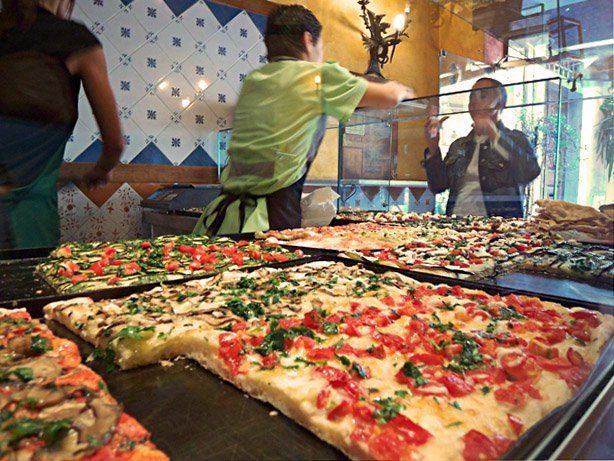 What better Rome food than pizza! A visit to Rome is only complete if you had the pizza the city has to offer. Unlike its thicker and softer Neapolitan cousin, Rome’s round pizza is thinner and crispier. With the same size and toppings, you’ll find that the Roman pizza is lighter and more rapidly eaten than its southern counterpart. But because Rome has it all, should you really long for a richer dough, you can always take care of that craving by heading to a “pizza al taglio” (“pizza by cut”) joint. This variety is usually baked in large rectangular trays and comes in endless combinations of toppings. On your first “pizza al taglio” experience, you’ll most likely find yourself quite confused with the choices before your eyes. And you may even start panicking a little in front of the pizzaiolo’s facial expression which screams “Can you decide already? I don’t have all day here!” and the hurried clients pushing up against you as if you were just an annoying obstacle between them and their precious… pizza. But worry not. Breathe. Keep calm and choose your pizza (and its size!) wisely. Here are some traditional round and “al taglio” pizzerias for our favorite Rome food: Forno Campo de’ Fiori (al taglio), Antico Forno Roscioli (al taglio), La Renella (al taglio), Ai Marmi (round) and Baffetto (round).
What better Rome food than pizza! A visit to Rome is only complete if you had the pizza the city has to offer. Unlike its thicker and softer Neapolitan cousin, Rome’s round pizza is thinner and crispier. With the same size and toppings, you’ll find that the Roman pizza is lighter and more rapidly eaten than its southern counterpart. But because Rome has it all, should you really long for a richer dough, you can always take care of that craving by heading to a “pizza al taglio” (“pizza by cut”) joint. This variety is usually baked in large rectangular trays and comes in endless combinations of toppings. On your first “pizza al taglio” experience, you’ll most likely find yourself quite confused with the choices before your eyes. And you may even start panicking a little in front of the pizzaiolo’s facial expression which screams “Can you decide already? I don’t have all day here!” and the hurried clients pushing up against you as if you were just an annoying obstacle between them and their precious… pizza. But worry not. Breathe. Keep calm and choose your pizza (and its size!) wisely. Here are some traditional round and “al taglio” pizzerias for our favorite Rome food: Forno Campo de’ Fiori (al taglio), Antico Forno Roscioli (al taglio), La Renella (al taglio), Ai Marmi (round) and Baffetto (round).
5. Maritozzo
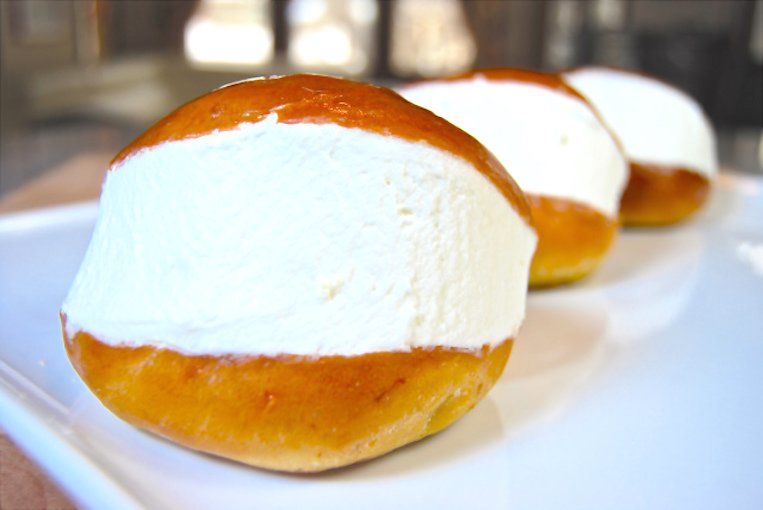 Finally, in Rome food also means sweets and desserts. One of them is called “maritozzo”, which translates to “almost husband” (from “marito” which is husband). The story behind the name is a cute one: soon-to-be grooms would gift these pastries to their future wife. And so the name “maritozzo” happened quite naturally. The first time you bite into a maritozzo, you’ll feel that everything that was said to you about eating a hearty meal in the morning was just a fat load of lies. Why have cereal, yogurt, almonds and a banana when you can have a fluffy pastry stuffed with such an abundance of cream that you’ll need to pause and reflect on the strategy to adopt for its successful consumption? How can a banana compete with this? It can’t. Period. So just toss out the window everything that was said to you about eating a healthy breakfast composed of all four food groups, and have yourself a breakfast with the only Rome food that counts at 8 AM: a maritozzo. Most coffee shops which have maintained some of the Roman traditions have them available in the morning. Safe bets for this Rome food are: Regoli, Dolci Desideri and Il Maritozzaro.
Finally, in Rome food also means sweets and desserts. One of them is called “maritozzo”, which translates to “almost husband” (from “marito” which is husband). The story behind the name is a cute one: soon-to-be grooms would gift these pastries to their future wife. And so the name “maritozzo” happened quite naturally. The first time you bite into a maritozzo, you’ll feel that everything that was said to you about eating a hearty meal in the morning was just a fat load of lies. Why have cereal, yogurt, almonds and a banana when you can have a fluffy pastry stuffed with such an abundance of cream that you’ll need to pause and reflect on the strategy to adopt for its successful consumption? How can a banana compete with this? It can’t. Period. So just toss out the window everything that was said to you about eating a healthy breakfast composed of all four food groups, and have yourself a breakfast with the only Rome food that counts at 8 AM: a maritozzo. Most coffee shops which have maintained some of the Roman traditions have them available in the morning. Safe bets for this Rome food are: Regoli, Dolci Desideri and Il Maritozzaro.
